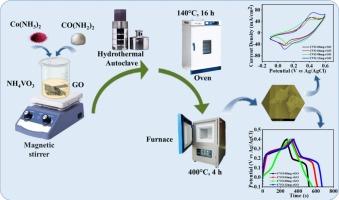Enhanced electrochemical performance of cobalt vanadium oxide supercapacitors through optimized reduced graphene oxide composite
IF 5.5
2区 材料科学
Q1 MATERIALS SCIENCE, CHARACTERIZATION & TESTING
引用次数: 0
Abstract
This study illustrates the strategic improvement of cobalt vanadium oxide (CVO) electrodes for supercapacitor applications by integrating reduced graphene oxide (rGO) through a hydrothermal synthesis method. The optimized CVO-12 mg-rGO composite had a specific capacitance of 327 F/g at 2 mA/cm2, an energy density of 11.34 Wh/kg, and a power density of 124 W/kg. This was better than pristine CVO and better than several other vanadate-based electrodes that have been reported. BET analysis showed that rGO exfoliation increased the surface area (16.26 m2/g) and made the pores easier to get to. EIS showed that the charge transfer resistance was lower (1.6 Ω). The made-up asymmetric device (CVO-12 mg-rGO//AC) showed that it could be used in real life by having a specific capacitance of 25.92 F/g, an energy density of 11.65 Wh/ kg, a high coulombic efficiency of about 99.9 %, and a great cycling retention of 70 % after 4.7 k cycles. These results show that combining pseudocapacitive CVO and conductive rGO in a synergistic way greatly improves the transport of electrons and ions, electrochemical reversibility, and long-term stability. The results show that CVO@rGO composites are promising electrodes for next-generation high-performance supercapacitors.

通过优化还原氧化石墨烯复合材料提高钴钒氧化物超级电容器的电化学性能
本研究通过水热合成方法集成还原氧化石墨烯(rGO),说明了用于超级电容器应用的钴钒氧化物(CVO)电极的战略性改进。优化后的cvo - 12mg - rgo复合材料在2 mA/cm2时的比电容为327 F/g,能量密度为11.34 Wh/kg,功率密度为124 W/kg。这比原始CVO和其他几种基于钒酸盐的电极都要好。BET分析表明,还原氧化石墨烯的剥离增加了孔隙的表面积(16.26 m2/g),使孔隙更容易到达。EIS显示电荷传递电阻较低(1.6 Ω)。结果表明,该非对称器件(CVO-12 mg-rGO//AC)具有25.92 F/g的比电容、11.65 Wh/ kg的能量密度、99.9%的库仑效率和高达70%的循环保留率,可用于实际生活。这些结果表明,将假电容性CVO和导电性rGO以协同方式结合在一起,大大提高了电子和离子的传递,电化学可逆性和长期稳定性。结果表明,CVO@rGO复合材料是下一代高性能超级电容器的理想电极。
本文章由计算机程序翻译,如有差异,请以英文原文为准。
求助全文
约1分钟内获得全文
求助全文
来源期刊

Materials Characterization
工程技术-材料科学:表征与测试
CiteScore
7.60
自引率
8.50%
发文量
746
审稿时长
36 days
期刊介绍:
Materials Characterization features original articles and state-of-the-art reviews on theoretical and practical aspects of the structure and behaviour of materials.
The Journal focuses on all characterization techniques, including all forms of microscopy (light, electron, acoustic, etc.,) and analysis (especially microanalysis and surface analytical techniques). Developments in both this wide range of techniques and their application to the quantification of the microstructure of materials are essential facets of the Journal.
The Journal provides the Materials Scientist/Engineer with up-to-date information on many types of materials with an underlying theme of explaining the behavior of materials using novel approaches. Materials covered by the journal include:
Metals & Alloys
Ceramics
Nanomaterials
Biomedical materials
Optical materials
Composites
Natural Materials.
 求助内容:
求助内容: 应助结果提醒方式:
应助结果提醒方式:


